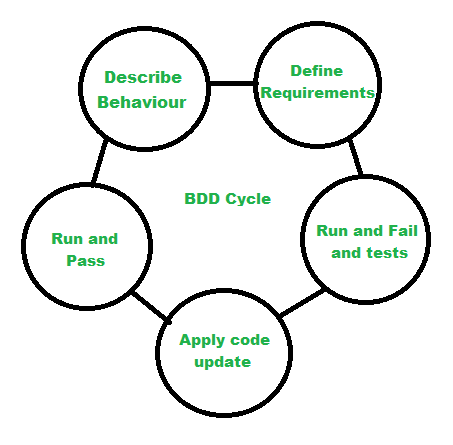What is behavior-driven development (BDD)?
Last Updated :
16 Nov, 2023
Behavioral Driven Development (BDD) refers to an Agile software development process that is derived from the TDD (Test Driven Development) methodology. BDD is considered a test to illustrate the behavior of the system. It encourages the use of conversation and concrete examples in simple language for everyone involved in the development to bring better clarity to the behavior of the system. In this development, techniques define various ways to develop a feature based on the system’s behavior, and the techniques are combined from Test Driven Development (TDD) and Domain Driven Development (DDD).
Behavioral Driven Development is a good approach in Automated Testing as it is more focused on the behavior of the system rather than the implementation of the code. BDD is facilitated through natural language to express the behavior of the system and the expected outcomes from the system. In BDD all parties are involved like a customer, developer, tester, and stakeholder for a collaborated conversation and illustration of the system’s behavior.
Behavior-Driven Development In Agile Development :
- The client and service provider have a conversation about what they need.
- The client/customer, developer, and tester elaborate on the requirements together.
- Then requirements are defined in structured scenarios.
- They help in the development and act as automated tests,
- These scenarios are used by the testers as the basis of tests.
BDD Life Cycle :

Behavior-Driven Development (BDD) Life Cycle
- Describe behavior –This includes the flow and features of the product means the main vision.
- Define requirements –Modeled requirements with business rules for a shared understanding.
- Run and fail the tests –Develop and run the test cases.
- Apply code update –Refactor it according to the requirement.
- Run and pass the tests –Run the updated code and pass the test cases.
But the important point is that BDD is not about testing like TDD. BDD is all about achieving business goals and requirements.
Making SDLC more Simple:
SDLC (Software Development Life Cycle) is considered a framework or specification for any software development. The BDD has a great contribution to making the SDLC process more simple.
- Defining requirements/system behavior in standard English makes the SRS (Software Requirement Specification) easier and clear.
- Gives a greater collaboration between Customers, Developers, and testers.
- It has a great positive impact on the testing and deployment stage.
Benefits of Behavioral Driven Development (BDD):
- Greater clarity on business goals and customer requirements.
- Reaches a larger customer set as it uses non-technical languages.
- Helps in defining acceptance criteria before development.
- Focuses on the system’s behavior from the client’s and developer’s point of view.
- Helps in avoiding unnecessary features and includes important features.
- Reduces effort for post-modification and post-deployment defects.
- Avoids misinterpretations during the development process.
- Collaboration between team members is promoted through BDD, involving all stakeholders in the development process to ensure a shared understanding of objectives.
- Automated testing tools are encouraged, reducing testing time and effort and enabling faster detection and resolution of issues.
- Integration with Continuous Integration and Delivery processes can automate the build, testing, and deployment of software, resulting in faster feedback loops and delivery of features.
- Detailed documentation of user stories, acceptance criteria, and step definitions can improve overall project documentation, facilitating maintenance and updates to the system.
- BDD prioritizes features based on their importance to the customer, ensuring that the development team is working on features that deliver real value to the business.
Limitations of Behavioral-Driven Development:
- BDD can be time-consuming to create and maintain extensive documentation, including user stories, acceptance criteria, and step definitions.
- Involving all stakeholders, especially non-technical stakeholders, can be a challenge.
- BDD tests heavily rely on the quality of initial requirements and user stories; incomplete or inaccurate requirements can lead to insufficient test coverage and bugs.
- BDD may not be suitable for short development cycles or projects with frequently changing requirements.
Share your thoughts in the comments
Please Login to comment...